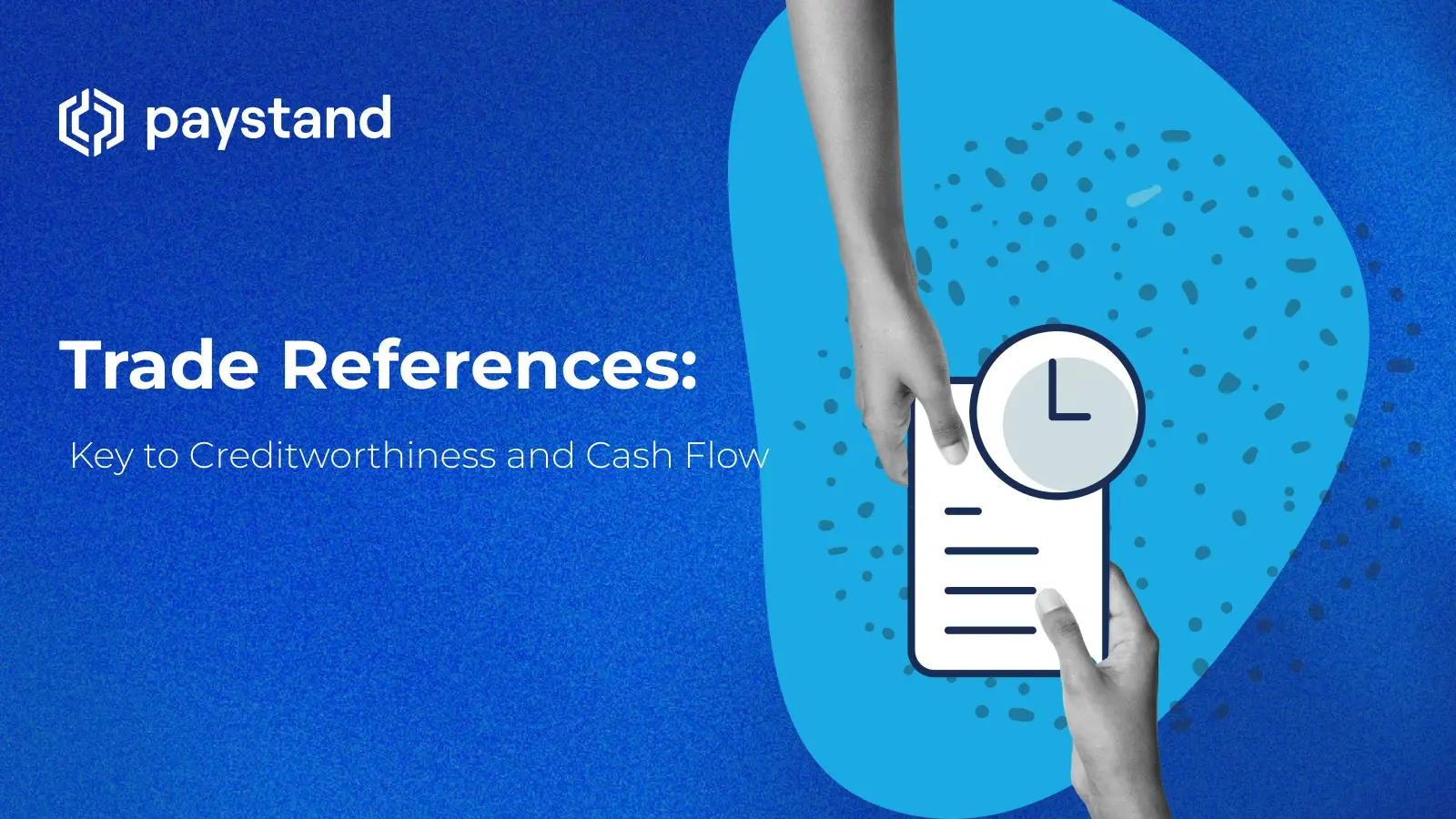Trade References: Key to Creditworthiness and Cash Flow

Table of Contents
- What are trade references?
- What important information is included in a trade reference?
- How can you help your customers create a trade reference?
- What are the best practices when evaluating trade references?
- How do accounts receivable payment portals assist with credit evaluation?
- Why trade references matter in the new financial era
Key Takeaways
- Trade references are vital trust signals in B2B finance, impacting credit decisions, business credibility, and cash flow, yet many companies underestimate their value.
- Strong trade references combine quantitative payment data with qualitative insights, enabling vendors, lenders, and partners to assess financial reliability beyond numbers.
- Businesses should automate trade reference creation, provide templates, verify accuracy, and use AR automation for real-time, reliable financial snapshots.
- Evaluating trade references requires a nuanced, pattern-focused approach, prioritizing consistency, recency, relevance, and direct validation to make confident credit decisions.
- Modern AR portals like Paystand convert trade references into blockchain-verified insights, automating credit evaluation and enabling finance teams to manage real-time risk and growth.
In a world where trust is currency and credit is oxygen, trade references quietly power some of the most pivotal decisions in B2B finance. Trade references are fundamental to modern businesses' operations, from helping new vendors establish credibility to giving lenders the confidence to extend terms. Yet, many finance teams still treat them as an optional step in the credit process.
The need for accurate, reliable trade references has never been more critical. With economic uncertainty still looming and supply chains tightening, companies scrutinize every transaction more precisely. According to a recent Dun & Bradstreet study, over 50% of trade credit decisions hinge on the strength of supplier references.
Competitors will gain credit, contracts, and customer loyalty if your company ignores trade references. They also significantly influence your business credit score, vendor onboarding, and cash flow management.
What are trade references, and why should they be central to your accounts receivable strategy? Let’s explore how this legacy tool is reimagined with modern platforms and automation.
What Are Trade References?
Trade references are statements or reports from suppliers or vendors that describe a company’s payment history and credit behavior. Think of them as professional endorsements in the financial world. When a business applies for credit, it provides trade references from previous or current vendors who can vouch for its reliability in paying bills on time.
This is more than just a nice-to-have. Trade references are often a crucial component of business credit reports, used by lenders, suppliers, and partners to assess financial risk. In a credit application, it’s proof that you’re a business worth trusting.
Credit bureaus use trade references to calculate creditworthiness. The more positive references you have, the more recent they are, the more likely your business will be granted favorable terms or financing.
What Important Information Is Included in a Trade Reference?
A solid trade reference includes key financial behaviors that build or erode trust. It’s a snapshot of customer financial behavior. Lenders request trade references not just for numbers, but for patterns, context, and character.
Key points included in a trade reference are:
- Vendor’s name and contact information
- Length of relationship with the customer
- Average invoice amount and payment terms
- Payment history (especially whether the customer pays on time, early, or late)
- Current balance and credit limit
- Any collection issues or disputes
Well-constructed trade references can also include a brief narrative section, in which vendors add qualitative observations about the relationship. These insights can be extremely valuable, especially in industries where reputation and collaboration matter as much as timely payments.
How Can You Help Your Customers Create a Trade Reference?
Businesses can proactively assist customers in creating impactful trade references by establishing a standardized request process. Here’s how:
-
Provide a template: Provide a form with the necessary fields mentioned above for convenience.
-
Encourage transparency: Inform customers about what’s being asked and how it benefits their credit.
-
Verify accuracy: Cross-check the details before sharing them. Misinformation helps no one.
-
Automate the process: Use accounts receivable automation to monitor customer payment data and produce real-time trade reference documents.
You should also educate customers on what to include when requesting a reference. Key elements of a strong request include:
- The purpose of the request (e.g., loan application, vendor onboarding)
- Period covered by the trade relationship
- Specific invoice numbers (if relevant)
- Contact details of the person submitting the reference
Helping customers secure strong trade references supports their growth, enhances your credibility, and demonstrates leadership in a financially conscious ecosystem.
What Are the Best Practices When Evaluating Trade References?
Evaluating trade references isn’t just about checking boxes. It’s about reading between the lines and using each reference to paint a fuller picture of a business’s financial behavior. Here's how to do it right:
Look for Consistency Across Multiple References
A single glowing review isn’t sufficient. Patterns are what matter most. Are vendors expressing similar opinions about payment behavior? Are the timelines and credit terms consistent across references? If so, that’s a green flag. Consistency among multiple vendors signals reliability and a strong credit culture.
Watch for Red Flags in the Details
Vague language, missing data, or overly generic responses should raise concerns. If a reference avoids specifics or provides only minimal detail, you may be dealing with a cautious or evasive company. Look closely for signs of disputes, missed payments, or changes in terms.
Pay Attention to Industry Relevance
Not all references carry equal weight. A positive reference from a company in a completely different industry might not provide much insight. When evaluating trade references, prioritize those from vendors with similar billing cycles, risk profiles, or operational dynamics. Relevance makes the insights actionable.
Explore the Timing of Payment Behavior
References from several years ago may not reflect a customer’s current financial health. Seek out the most recent and relevant data. A company that paid promptly three years ago may have changed significantly since then. The more current the information, the more confident you can be in your credit decisions.
Call the References Directly for Validation
Whenever possible, speak with the reference contact. This allows you to ask follow-up questions, confirm the details provided, and gauge tone and nuance that a written form might miss. Direct communication also adds a layer of verification to ensure the legitimacy of the reference.
And here’s a pro tip: Combine reference evaluations with data from accounts receivable management platforms. This helps you cross-reference what’s said against what’s been paid and when. This layered approach is what modern, data-driven credit evaluation looks like.
How Do Accounts Receivable Payment Portals Assist With Credit Evaluation?
Traditional trade references can’t scale fast enough in the automation and digital finance era. That’s where accounts receivable payment portals step in.
These portals, especially those powered by accounts receivable automation, can track payment histories, flag inconsistencies, and even auto-generate trade references based on real-time transactional data. Here's how they support better credit evaluation:
- Centralized data collection: All payment interactions are logged in the accounts receivable payment portal, creating a single source of truth for financial transactions. This simplifies identifying patterns, verifying references, and evaluating credit without searching through fragmented systems.
- Instant reporting: Waiting for vendors to email PDF reports is outdated. With real-time dashboards and exportable data, finance teams can instantly access credit indicators, customer payment behavior, and other previously buried metrics.
- Automated alerts: Payment portals trigger alerts for abnormal customer behavior, such as late payments, reduced transaction sizes, or sudden term changes. Automated notifications enable credit managers to respond quickly, preventing issues from escalating.
- Improved cash flow management: Connecting trade references to payment performance gives businesses an early warning system for revenue interruptions. This insight helps companies make better decisions about extending credit, tightening terms, or preparing for liquidity gaps.
- Stronger B2B payments visibility: Modern portals aggregate payment data from multiple relationships, offering a fuller view of customer behavior across their vendor network. This enhances confidence in credit decisions and reduces reliance on isolated references.
This is where legacy systems falter; they depend on manual entry, fragmented communication, and outdated information. Payment portals reverse that equation.
Why Trade References Matter in the New Financial Era
As blockchain, smart contracts, AI, and decentralized finance redefine trust in business, trade references are evolving from a subjective tool to transparent, data-backed insights for B2B payments.
Today, platforms like Paystand lead the charge. Paystand's billing and payment portal unlocks value at every step of the transaction lifecycle. By embedding trade reference logic, Paystand allows businesses to:
- Instantly access verified payment histories
- Improve credit decisions with real-time data
- Automate reference creation for AR teams
- Reduce risk by identifying poor payers before problems arise
- Integrate trade reference data into accounts receivable workflows
Because Paystand operates on a decentralized, blockchain-based infrastructure, the data driving these insights is immutable and secure, an essential foundation for the trust economy.
This isn’t just a product feature; it’s a financial revolution. One where intelligent, transparent, and mission-aligned platforms replace outdated, manual, opaque processes. If you haven’t moved into the new wave, here’s how. It’s still your chance to make a difference.
Rethink what you thought you knew about trade references. Stop treating them like old paperwork and leverage them as strategic assets in your credit process, accounts receivable management, and cash flow management.
Paystand is building the future of finance: blockchain-native, zero-fee, and radically open. Ready to be part of the change? Explore the billing and payment portal and take the next step toward transforming how your business evaluates credit, manages risk, and drives growth.






